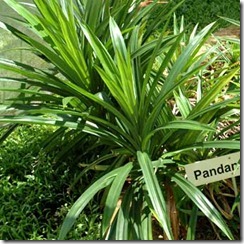香兰叶 Pandan (Pandanus amaryllifolius)
Categories: 分享; Tagged with: Pandan • 香兰叶; @ November 2nd, 2012 0:11晚上冲凉的时候闻到一股从未闻过的香味, 应该不是我的体香. 感觉起来像是植物煮熟的那种很纯很天然的香气, 我一直觉得扁豆的味道就很香, 但这个更香.
是房东在煮夜宵, 分了我一碗, 我一看就是地瓜嘛, 可我在国内吃了无数的地瓜也没闻到过这样的香气. 喝起来就没有闻起来的那么香, 问了之后才知道香气来自”香兰叶”, 煮完汤, 叶子就扔掉了. 房东还从垃圾桶里扒拉出一片完整的叶子给我看…
Common Name:
Pandan, Screw Pine
Scientific Name:
Pandanus amaryllifolius
Description:
The leaves of the screw pine have small thorns towards the apex along the margins and midrib. A freshly cut leaf has a delightful fragrance like that of a new hay. The plant never flowers and is propagated by cuttings.
Uses:
The leaves are used as flavouring in cooking. Juice extracted can be used as an essence in cake making or the entire leaf used with coconut water and rice to make nasi-lemak.
Wiki:
Pandan (P. amaryllifolius) leaves are used in Southeast Asian cooking to add a distinct aroma to rice and curry dishes such as nasi lemak, kaya (‘jam’) preserves, and desserts such as pandan cake. In Indian cooking, the leaf is added whole tobiryani, a kind of rice pilaf, made with ordinary rice (as opposed to that made with the premium-grade Basmati rice). The basis for this use is that both Basmati and Pandan leaf contain the same aromatic flavoring ingredient, 2-Acetyl-1-pyrroline. Pandan leaf can be used as a complement to chocolate in many dishes, such as ice cream. They are known as daun pandan in Indonesian and Malay; 斑蘭 (bān lán) in Mandarin and as ใบเตย (bai teuy) in Thailand. Fresh leaves are typically torn into strips, tied in a knot to facilitate removal, placed in the cooking liquid, then removed at the end of cooking. Dried leaves and bottled extract may be bought in some places.
http://en.wikipedia.org/wiki/Pandanus
百度百科上, 很随意的说:
香兰叶是东南亚常用的香料之一,可以打成汁液添加在甜点内,也可将新鲜的香兰叶用于炖煮或用来包裹食物油炸,添加在白饭中一起煮,煮好的饭会有股特殊香味,相当诱人,新鲜的香兰叶汁还可以用来替食物染色。马来西亚的娘惹(Nyonya—华侨与当地土著生下的女性后裔)就喜欢把这种植物加入食物里,因为它有一种十分独特的天然芳香味,能让食物增添清新、香甜的味道。后来慢慢地演变到以新鲜椰汁混合香兰叶来制作各种食物与糕点。而在蛋糕、面包、饼干、慕斯等食品中加入香兰叶,吃起来更爽口、更香甜、更美味!
